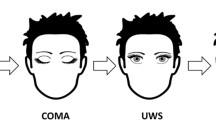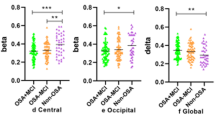Abstract
Electroencephalographic recordings in cirrhotic patients without overt hepatic encephalopathy (HE) have mainly been performed during wakefulness. Our aim was to quantify their alterations in nocturnal sleep electroencephalogram (EEG). In 20 patients and 20 healthy volunteers, we recorded a nocturnal digital polysomnography. Different sleep parameters were measured. Besides, we performed quantitative analysis of EEG (qEEG) as follows: spectral power in the different sleep stages was calculated in the frequency bands low δ, δ, θ, α, and σ. Also, the mean dominant frequency and Sleep Indexes were obtained. In comparison with controls, the group of patients showed (1) different alterations in both the microstructure and the macrostructure of sleep; (2) an increase in, both, θ band power and the average mean dominant frequency during rapid eye movement (REM); (3) in all sleep stages, a decrease of sleep electroencephalogram spectral power in low δ band and an increase in δ band: and (4) in stages N3 and REM, significant increases in the minimum of mean dominant frequency and in the respective sleep indexes. Therefore, in cirrhotic patients without overt HE, and likely having minimal hepatic encephalopathy, we found different alterations in both the microstructure and the macrostructure of nocturnal sleep. Also, sleep qEEG showed a brain dysfunction in slow oscillatory mechanisms intrinsic of sleep stages, with an increase in the frequency of its maximal electroencephalogram synchronization, from low δ to δ band. These alterations may reflect the onset of encephalopathy; sleep qEEG may, thus, be an adequate tool for its brain functional evaluation and follow-up.






Similar content being viewed by others
References
Aeschbach D, Borbély AA (1993) All-night dynamics of the human sleep EEG. J Sleep Res 2:70–81
Albrecht J, Jones EA (1999) Hepatic encephalopathy: molecular mechanisms underlying the clinical syndrome. J Neurol Sci 170:138–146
Amodio P, Marchetti P, Del Piccolo F, de Tourtchaninoff M, Varghese P et al (1999) Spectral versus visual EEG analysis in mild hepatic encephalopathy. Clin Neurophysiol 110:1334–1344
Amodio P, Valenti P, Del Piccolo F, Pellegrini A, Schiff S et al (2005) P300 latency for the diagnosis of minimal hepatic encephalopathy: evidence that spectral EEG analysis and psychometric tests are enough. Dig Liver Dis 37:861–868
Amzica F, Steriade M (1998) Cellular substrates and laminar profile of sleep K-complex. Neuroscience 82:671–686
Amzica F, Steriade M (1998) Electrophysiological correlates of sleep delta waves. Clin Neurophysiol 107:69–83
Bajaj JS (2008) Minimal hepatic encephalopathy matters in daily life. World J Gastroenterol 14(23):3609-3615
Bajaj JS, Saeian K, Schubert CM, Franco R, Franco J et al (2011) Disruption of sleep architecture in minimal hepatic encephalopathy and ghrelin secretion. Aliment Pharmacol Ther 34:103–105
Bajaj JS, Wade JB, Sanyal AJ (2009) Spectrum of neurocognitive impairment in cirrhosis: Implications for the assessment of hepatic encephalopathy. Hepatology 50:2014–2021
Bersagliere A, Raduazzo ID, Nardi M, Schiff S, Gatta A et al (2012) Induced hyperammonemia may compromise the ability to generate restful sleep in patients with cirrhosis. Hepatology 55:869–878
Butterworth RF (2000) Complications of cirrhosis III. Hepatic encephalopathy. J Hepatol 32:171–180
Carskadon MA, Dement WC (2000) Normal human sleep: an overview. In: Krieger MH, Roth T, Dement WC (eds) Principles and practice of sleep medicine. Saunders, Philadelphia, pp 15–25
Connors BW, Gutnick MJ, Prince DA (1982) Electrophysiological properties of neocortical neurons in vitro. J Neurophysiol 48:1302–1320
Córdoba J, Cabrera J, Lataif L, Penev P, Zee P et al (1998) High prevalence of sleep disturbance in cirrhosis. Hepatology 27:339–345
Crunelli V, Hughes SW (2010) The slow (<1 Hz) rhythm of non-REM sleep: a dialogue between three cardinal oscillators. Nat Neurosci 13:9–17
Dhiman RK, Saraswat VA, Sharma BK, Sarin SK, Chawla YK et al (2010) Minimal hepatic encephalopathy: consensus statement of a working party of the Indian National Association for Study of the Liver. J Gastroenterol Hepatol 25:1029–1041
Felipo V, Butterworth RF (2002) Neurobiology of ammonia. Prog Neurobiol 67:259–279
Felipo V, Urios A, Montesinos E, Molina I, Garcia-Torres M et al (2012) Contribution of hyperammonemia and inflammatory factors to cognitive impairment in minimal hepatic encephalopathy. Metab Brain Dis 27:51–58
Ferenci P, Lockwood A, Mullen K, Tarter R, Weissenborn K et al (2002) Hepatic encephalopathy—definition, nomenclature, diagnosis, and quantification: Final report of the Working Party at the 11th World Congresses of Gastroenterology, Vienna, 1998. Hepatology 35:716–721
Iber C A-IS, Chesson A, Quan SF (2007) The AASM manual for the scoring of sleep and associated events: rules, terminology and technical specifications. In: IAAoSM (ed). American Academy of Sleep Medicine. Westchester
Lombardi G, Mannaioni G, Leonardi P, Cherici G, Carlà V et al (1994) Ammonium acetate inhibits ionotropic receptors and differentially affects metabotropic receptors for glutamate. J Neural Transm Gen Sect 97:187–196
Martino ME, Romero-Vives M, Fernandez-Lorente J, De Vicente E, Barcena R et al (2002) Sleep electroencephalogram alterations disclose initial stage of encephalopathy. Methods Find Exp Clin Pharmacol 24(Suppl D):119–122
Montagnese S, Middleton B, Mani A, Skene D, Morgan M (2009) Sleep and circadian abnormalities in patients with cirrhosis: features of delayed sleep phase syndrome? Metab Brain Dis 24:427–439
Montagnese S, Middleton B, Skene DJ, Morgan MY (2009) Night-time sleep disturbance does not correlate with neuropsychiatric impairment in patients with cirrhosis. Liver Int 29:1372–1382
Montgomery J, Bajaj J (2011) Advances in the evaluation and management of minimal hepatic encephalopathy. Curr Gastroenterol Rep 13:26–33
Rechtschaffen A, Kales A (1968) A manual of standardized terminology, techniques and scoring systems for sleep stage of human subjects. Institute UBISBR, Los Angeles
Sagalés T, Gimeno V, Calzada MD, Casellas F, Macià MD et al (1990) Brain mapping analysis in patients with hepatic encephalopathy. Brain Topogr 2:221–228
Saxena N, Bhatia M, Joshi YK, Garg PK, Dwivedi SN et al (2002) Electrophysiological and neuropsychological tests for the diagnosis of subclinical hepatic encephalopathy and prediction of overt encephalopathy. Liver 22:190–197
Silber MH, Ancoli-Israel S, Bonnet MH, Chokroverty S, Grigg-Damberger MM et al (2007) The visual scoring of sleep in adults. J Clin Sleep Med 3:121–131
Steriade M, Contreras D, Curro Dossi R, Nunez A (1993) The slow (<1 Hz) oscillation in reticular thalamic and thalamocortical neurons: scenario of sleep rhythm generation in interacting thalamic and neocortical networks. J Neurosci 13:3284–3299
Van der Rijt CCD, Schalm SW, de Groot GH, de Vlieger M (1984) Objective measurement of hepatic encephalopathy by means of automated EEG analysis. Electroencephalogr Clin Neurophysiol 57:423–426
Acknowledgments
This work was supported by FIS 00/0457 and FIS G03/155 to JMG. MEM was a recipient of a post-doctoral fellowship (FIS G03/155). The authors wish to thank Dr. Angel Núñez for his valuable comments and Verónica García-Vázquez for her suggestions on data analysis.
Author information
Authors and Affiliations
Corresponding author
Rights and permissions
About this article
Cite this article
Martino, M.E., Fernández-Lorente, J., Romero-Vives, M. et al. Brain oscillatory activity during sleep shows unknown dysfunctions in early encephalopathy. J Physiol Biochem 70, 821–835 (2014). https://doi.org/10.1007/s13105-014-0351-2
Received:
Accepted:
Published:
Issue Date:
DOI: https://doi.org/10.1007/s13105-014-0351-2




